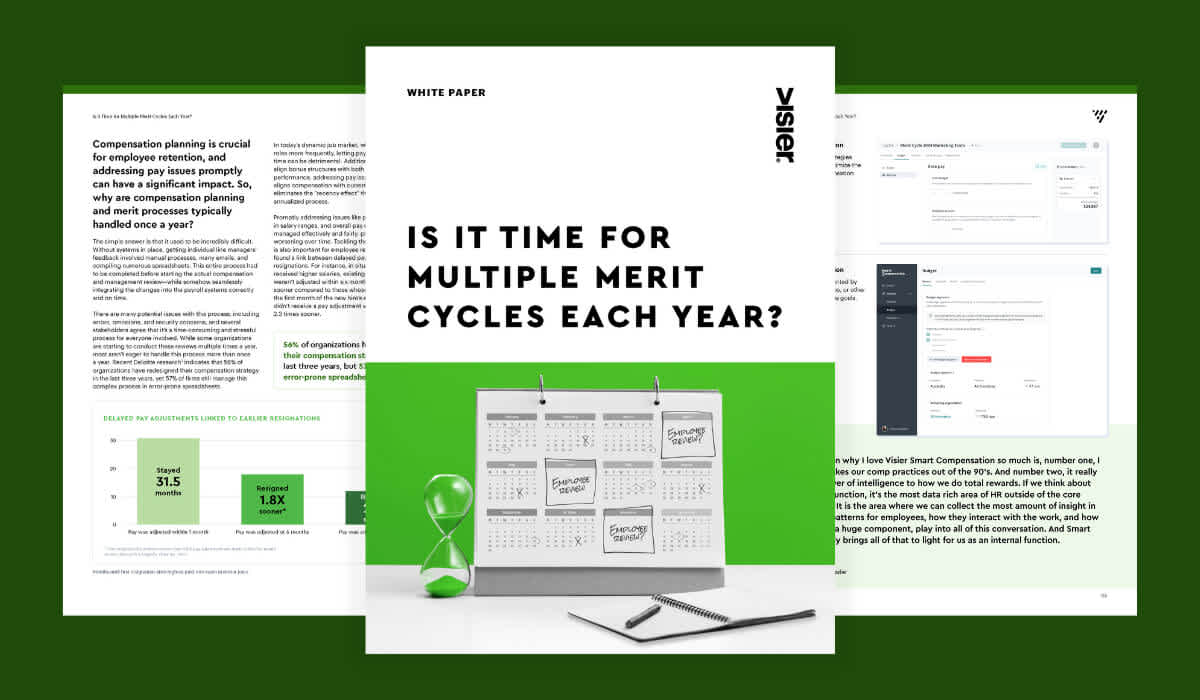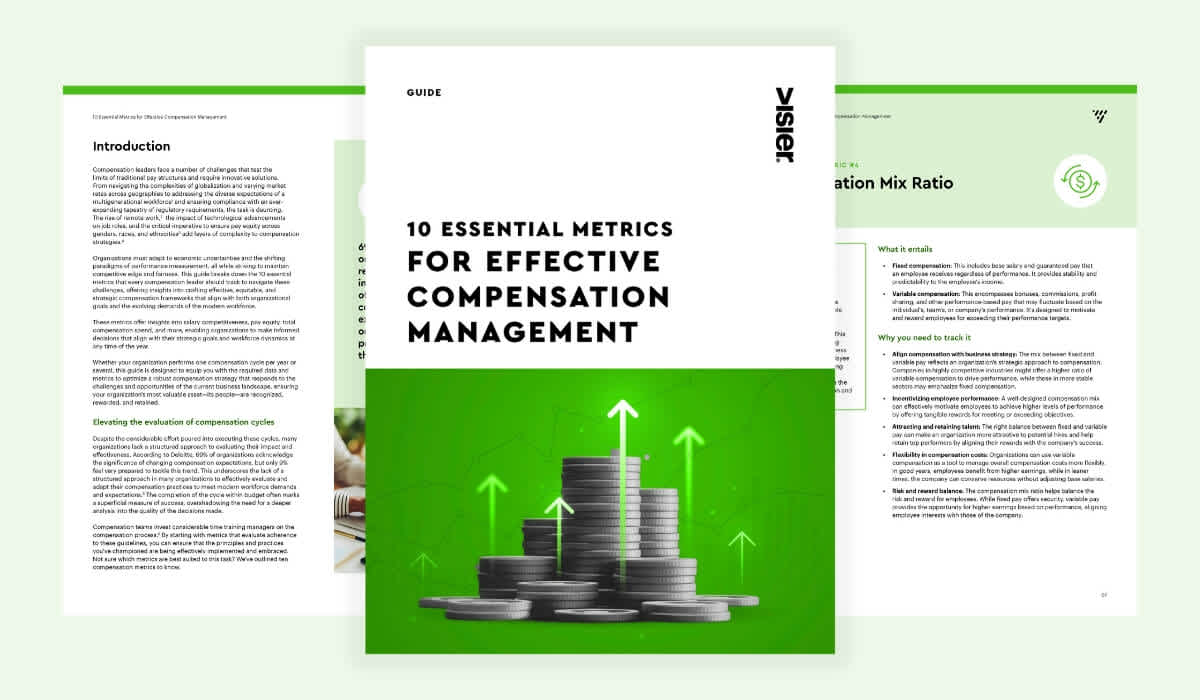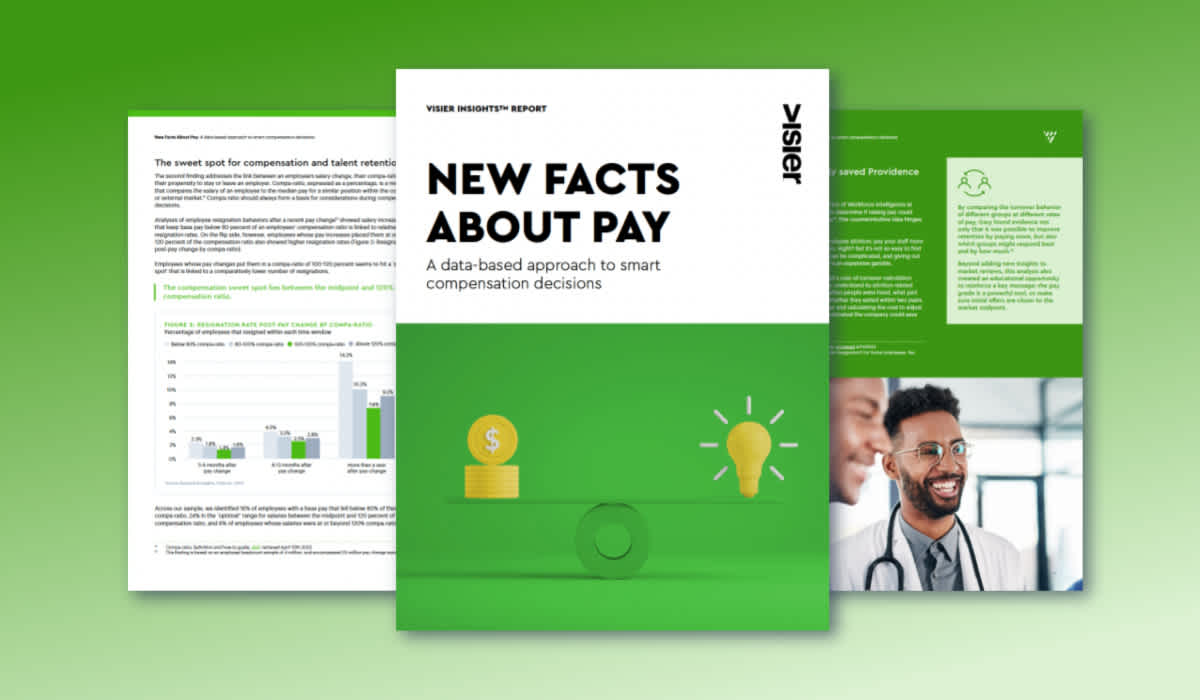Planning and Executing Merit Increases That Drive Retention
Learn how to design and implement strategic merit increase programs that reward performance, ensure equity, and maximize retention impact using data-driven approaches.

With merit increase budgets now averaging 3.3% according to recent Mercer data, HR leaders are dealing with a critical question: “How can we maximize retention while maintaining pay equity across the organization?”
Merit increases, as the name suggests, are based on merit. Employees earn these pay increases due to positive performance. Unlike salary or cost-of-living adjustments, which are applied across the board, merit increases are a way to recognize top talent and drive organizational success.
Executing merit increases effectively, though, requires objectivity and a data-driven approach to determine who is eligible for a merit increase and how much that increase should be. This requires a balance between individual performance, market impacts, and business objectives.
We walk through the essential elements:
Successful and equitable merit increase programs
Understanding the difference between merit and market adjustments
Developing data-driven budgets
Ensuring equitable distribution

Merit increases vs. market adjustments: Understanding key differences
An effective total rewards strategy balances merit increases with other compensation adjustments to reward performance and maintain competitiveness. Each type of adjustment serves a specific purpose:
Merit increases are performance-based salary adjustments designed to reward individual performance. They’re used to recognize and reward employees who have exceeded expectations, achieved key goals, or provided exceptional value to the company.
Market adjustment increases are meant to ensure compensation remains competitive with the market. That's why companies need to align their compensation practices with other employers to attract and retain employees, especially for key roles.
Cost-of-living adjustments are meant to address inflation and economic changes. They’re not tied to performance and are typically applied across the board to ensure that overall pay rates are adjusted to address economic impacts.
Promotional pay increases are tied to changes in roles and responsibilities. These typically range from 6-12% or more, depending on the scope of the new position.
The power of merit increases lies in their ability to create clear connections between individual contributions and financial rewards. When employees see tangible recognition for exceptional performance, they're more likely to maintain high engagement levels and stay with the organization.
Data-driven budgeting: Strategic approach to merit planning
Effective merit increase budgeting starts with understanding your organization's total compensation landscape and market positioning. Mercer indicates that merit increase budgets in 2025 have maintained consistency with 2024 levels.�
Effective merit budgeting requires an understanding of where employees are currently within their salary ranges and building a framework to ensure consistent and fair salary distribution.
Establishing budget parameters
When considering compensation budgets, a good starting point is to analyze current compensation levels to see where employees currently are within the salary ranges for their positions.
The compensation ratio, or compa-ratio, is a strong indication of what you need to provide employees meaningful pay increases. For instance, employees who are below the midpoint of their salary range may require larger increases to maintain competitiveness both internally and externally.
Technology companies are budgeting 3.5% for merit increases in 2025, while healthcare organizations project 3.0%. These industry variations reflect different talent market dynamics and competitive pressures.
Merit matrix development
A well-constructed merit matrix can help to balance performance ratings with current compensation positioning.
High performers sitting below the market midpoint for their positions should receive larger increases than those who are already being paid above the range midpoint. Using this approach ensures meaningful progression within the range while also helping you manage budget constraints.
Consider implementing recommended ranges for pay increases based on performance levels. For instance, a 4-6% range for exceptional performance and a 0-1% for performance that’s below expectations.
Merit increase budgets don't have to be the same across the entire organization. Critical roles with high turnover risk might warrant larger merit pools, while stable functions might receive standard allocations.
Advanced analytics lets you find which employees have the highest flight risk and greatest business impact. This way, you can target merit increases where they'll generate maximum retention value.
Ensuring equity and fairness in merit distribution
Pay equity compliance has become increasingly critical as transparency legislation expands globally. For example, the European Union's Pay Transparency Directive (effective June 2026) calls for companies to maintain pay gaps below 5%. This makes equitable merit increase distribution essential for compliance and organizational integrity.
Achieving this level of equity requires attention to four critical areas:
Bias prevention in merit decisions
Traditional performance evaluation processes are prone to introducing unconscious bias that can skew merit increase decisions. Recency bias, for instance, may favor employees who completed high-visibility projects shortly before their review time. Affinity bias could only benefit employees with similar interests and styles to their managers.
One way to avoid these types of biases is to implement structured evaluation criteria and require documentation for all merit increase recommendations. Companies may also want to implement calibration sessions where managers and their HR partners can discuss intended increases and identify potential disparities.
Multi-source performance assessment
Another way to improve the equity and appropriateness of pay increases is to use multiple data points in merit decisions. This might involve combining performance review scores with objective metrics like goal achievement, peer feedback, customer satisfaction scores, and recognition awards. This multi-source approach gives you an accurate and balanced picture of employee contributions.
Technology platforms that aggregate data from multiple systems can reveal patterns that might not be apparent in traditional performance reviews. For example, sales performance data combined with team collaboration metrics provides fuller insight into an employee's total impact.
Equity analysis and monitoring
It’s important to regularly evaluate potential inequities in pay that could be exacerbated by merit increase distributions. Examine pay patterns by demographic groups, departments, and job levels to help spot emerging trends before they become compliance issues.
If you spot disparities, create remediation plans that include targeted adjustments outside of the standard merit cycle. Document these efforts to demonstrate proactive equity management.
Transparency in merit increase criteria
Clearly communicate merit increase criteria and processes to all employees. This can be done with multiple communication channels, including face-to-face communication and access to on-demand information. The latter might include your process for establishing merit increases, along with your matrix, and responses to FAQs.
Document the process in writing, then follow up through team meetings, email updates, and your employee handbook. This creates transparency and encourages employees to focus on the behaviors that drive merit recognition above all else.
Strategic communication and rollout
How you communicate merit increase decisions can significantly impact their effectiveness as motivation and retention tools. Poor communication can undermine the most well-designed merit programs, while thoughtful messaging reinforces the connection between performance and rewards.
Ensure that managers and supervisors are well-versed in the process and comfortable discussing with employees and responding to their questions. To ensure your merit increase communications achieve their intended impact, focus on these implementation elements:
Manager training and preparation
Give managers comprehensive information about their team members' merit increases, including the rationale behind each decision. Provide talking points that help them explain how individual performance, market positioning, and budget constraints influenced final amounts.
Train managers to have meaningful conversations that go beyond simply announcing the pay increase amount. Effective discussions should connect the merit increase to specific achievements, outline future growth opportunities, and reinforce behavioral expectations.
Timing and sequencing
Plan merit increase communications to maximize positive impact. Avoid delivering merit increase news during busy periods or immediately before major organizational announcements that might overshadow the recognition.
Consider staggering communications based on employee performance levels. Top performers might receive early notification to reinforce their value, while others receive information during the standard cycle.
Addressing different outcomes
Prepare managers to handle various employee reactions, from gratitude to disappointment. For employees receiving smaller increases, focus conversations on development opportunities and specific actions that could lead to higher merit recognition in future cycles.
For employees getting no merit increase, managers should be able to clearly explain the decision and provide actionable feedback for improvement. These conversations, while difficult, come in to support maintaining trust and motivation.
Documentation and follow-through
Document merit increase conversations to ensure consistency and provide reference points for future discussions. Follow up with employees to gauge their understanding and address any remaining questions or concerns.
Use merit increase communications as launching points for ongoing performance discussions throughout the year, rather than one-time events.
Measuring impact: Retention, morale, and performance outcomes
The ultimate test of merit increases effectiveness lies in measurable business outcomes. Successful programs should demonstrate positive impacts on:
Retention analysis
Track turnover rates for employees who received different merit increase levels to understand the retention impact of your investments. Analyze whether employees receiving above-average increases show lower turnover than those receiving standard amounts.
Examine time-to-turnover data to identify optimal merit increase timing. If employees frequently leave within months of receiving merit increases, look into whether the amounts weren't enough or if other factors drove their departure decisions.
Engagement and satisfaction monitoring
Measure employee satisfaction with compensation fairness and merit increase processes through regular surveys. Track changes in engagement scores following merit increase cycles to gauge program effectiveness.
Pay particular attention to engagement levels among employees who received no merit increase or below-average amounts. Declining satisfaction in these groups may indicate communication or equity issues that need addressing.
Performance correlation analysis
Evaluate whether merit increase recipients maintain or improve their performance levels following the increases. Strong programs should show sustained high performance from merit recipients, validating the investment.
Analyze team and departmental performance metrics to assess whether merit increase programs contribute to broader organizational success. Look for correlations between merit increase distribution and key business outcomes like customer satisfaction, productivity measures, or revenue generation.
Program refinement and optimization
Use outcome data to continuously improve merit increase programs. If analysis shows certain approaches generating better results, adjust future programs accordingly.
Consider conducting longitudinal studies to understand the long-term impact of merit increase strategies on career progression, performance sustainability, and organizational culture.
Cost-benefit evaluation
Calculate the total cost of merit increase programs, including administrative overhead. Then, compare this against retention savings and productivity gains. Don't forget to factor in the costs of replacing high-performing employees to understand the full return on merit increase investments.
Regular cost-benefit analysis helps justify merit increase budgets to senior leadership and ensures resources are allocated effectively across different talent segments.
Interested in learning more about strategic merit increase planning? Visier can help you develop, implement, monitor, and maintain a comp strategy designed to reward your employees while boosting productivity and retention.

Frequently asked questions
What is a merit increase and how does it differ from bonuses?
A merit increase is a permanent salary adjustment based on individual performance, while bonuses are typically one-time payments. Merit increases become part of an employee's base salary and compound over time, making them more valuable for long-term retention and employee financial security.
How should budgets for merit increases be set?
Merit increase budgets should reflect market conditions, organizational performance, and strategic talent priorities. Start with industry benchmarks (3.3-3.7% for 2025), then adjust based on your company's financial position, talent market competitiveness, and retention goals. Allocate budgets strategically rather than equally across all departments.
How can companies ensure pay equity in merit increases?
Implement structured evaluation criteria, require documentation for all merit decisions, and conduct regular equity analyses by demographic groups and job levels. Use multi-source performance data to reduce bias and provide manager training on fair evaluation practices. Consider calibration sessions to identify and address potential disparities.
How do you communicate merit increases effectively?
Train managers to connect merit increases to specific achievements and future opportunities. Provide a clear rationale for decisions, especially for employees receiving smaller or no increases. Focus on development pathways and ensure consistent messaging across the organization. Document conversations and follow up to address questions.
What metrics show success post-raise?
Monitor retention rates by merit increase level, employee engagement scores, performance sustainability among recipients, and business outcomes like productivity and customer satisfaction. Track cost-benefit ratios, including replacement costs for departing high performers. Conduct regular program evaluations to identify optimization opportunities.


